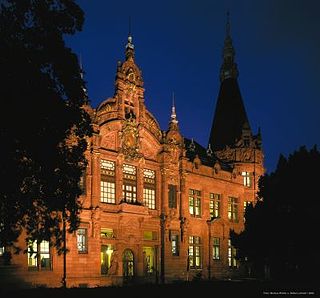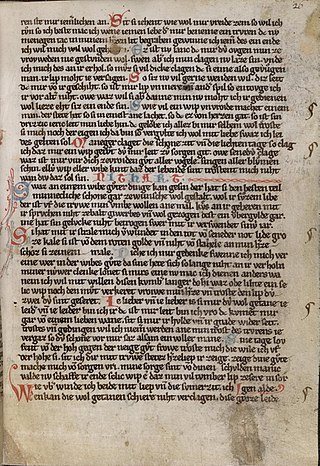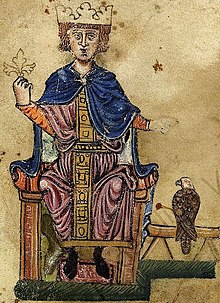
Heidelberg University, officially the Ruprecht Karl University of Heidelberg, is a public research university in Heidelberg, Baden-Württemberg, Germany. Founded in 1386 on instruction of Pope Urban VI, Heidelberg is Germany's oldest university and one of the world's oldest surviving universities; it was the third university established in the Holy Roman Empire after Prague (1347) and Vienna (1365). Since 1899, it has been a coeducational institution.

The Vatican Apostolic Library, more commonly known as the Vatican Library or informally as the Vat, is the library of the Holy See, located in Vatican City, and is the city-state's national library. It was formally established in 1475, although it is much older—it is one of the oldest libraries in the world and contains one of the most significant collections of historical texts. It has 75,000 codices from throughout history, as well as 1.1 million printed books, which include some 8,500 incunabula.

Leo Allatius was a Greek scholar, theologian, and keeper of the Vatican library.

The Codex Aureus of Lorsch or Lorsch Gospels is an illuminated Gospel Book written in Latin between 778 and 820, roughly coinciding with the period of Charlemagne's rule over the Frankish Empire. Both the manuscript and the carved ivory panels from the cover are rare and important survivals from the art of this period.

Lorsch Abbey, otherwise the Imperial Abbey of Lorsch, is a former Imperial abbey in Lorsch, Germany, about 10 km (6.2 mi) east of Worms. It was one of the most important monasteries of the Carolingian Empire. Even in its ruined state, its remains are among the most important pre-Romanesque–Carolingian style buildings in Germany.
The so-called Preußische Instruktionen or PI are a cataloging set of rules for libraries which was used in scientific libraries in German-speaking countries and beyond. First published in 1899, the PI were replaced by other sets of rules such as the Regeln für die alphabetische Katalogisierung (RAK) from the 1980s onwards, which in turn have been replaced by the Resource Description and Access (RDA) rules since 2015.

The Palatine Anthology, sometimes abbreviated AP, is the collection of Greek poems and epigrams discovered in 1606 in the Palatine Library in Heidelberg. It is based on the lost collection of Constantine Kephalas of the 10th century, which in turn is based on older anthologies. It contains material from the 7th century BC until 600 AD and later on was the main part of the Greek Anthology which also included the Anthology of Planudes and more material.

The Church of the Holy Spirit is the largest church in Heidelberg, Germany. The church, located in the marketplace in the old town center, was constructed between 1398 and 1515 in the Romanesque and Gothic styles. It receives 1–3 million guests annually, making it among the most visited churches in Germany.

Franz Ehrle was a German Jesuit priest and a cardinal of the Roman Catholic Church. He served as the Archivist of the Secret Archives of the Vatican, in the course of which he became a leading agent in the revival of Thomism in the teachings of the Catholic Church.

The Heidelberg University Library is the central library of the Heidelberg University. Together with the 83 decentralized libraries of the faculties and institutes, it forms the University Library System, which is headed by the director of the University Library. The University Library holds special collections in literature concerning the Palatinate and Baden, egyptology, archeology, the history of art, and South Asia. It holds about 3.2 million books, 6,000 printed scientific periodicals, and about 500,000 other media such as microfilms and video tapes. The libraries of the faculties and institutes hold another 3 million printed books. In 2022, the University Library registered 43,600 active users who accessed more than 746,000 books. The conventional book supply is complemented by numerous electronic services, including approximately 152,00 electronic journals. The University Library provides around 1,100 reading- and workspaces in the main library in the old town and around 320 reading- and workspaces in the branch in the Neuenheimer Feld, including many IT-workstations and research stations equipped with PCs.

The Indiculus superstitionum et paganiarum is a Latin collection of capitularies identifying and condemning superstitious and pagan beliefs found in the north of Gaul and among the Saxons during the time of their subjugation and conversion by Charlemagne.
Genesis is an Old Saxon Biblical poem recounting the story of the Book of Genesis, dating to the first half of the 9th century, three fragments of which are preserved in a manuscript in the Vatican Library, Palatinus Latinus 1447. It and the Heliand, a heroic poem based on the New Testament, a fragment of which is also included in the same manuscript, constitute the only major records of Old Saxon poetry. It is also the basis of the Anglo-Saxon poem known as Genesis B, and Eduard Sievers postulated its existence on linguistic evidence before the manuscript was discovered.

Karl Friedrich Wilhelm Zangemeister was a German librarian and philologist.

The Kleine Heidelberger Liederhandschift is a collection of Middle High German Minnesang texts. In Minnesang scholarship it is referred to as MS. A. It is held by the Heidelberg University Library with the signature Cod.Pal.germ. 357.

Fragmentarium is an online database to collect and collate fragments of medieval manuscripts making them available to researchers, collectors and historians worldwide. It is an international collaboration of major libraries and collections including the British Library, Bibliothèque nationale de France, Martin Schøyen Collection, Bavarian State Library, Harvard, Yale and the Vatican. It is based in Switzerland and the project's current director is Professor Christoph Flüeler from the University of Fribourg and the Virtual Manuscript Library, Switzerland.
Ulrich Pfisterer is a German art historian whose scholarship focuses on the art of Renaissance Italy. He is currently a professor of art history at Ludwig Maximilian University of Munich and the director of the Zentralinstitut für Kunstgeschichte.

The Universitätsbibliothek Würzburg is the central library of the Julius-Maximilians-Universität Würzburg. As a regional library of Lower Franconia, it collects Lower Franconian literature. The Universitätsbibliothek Würzburg is maintained by the Free State of Bavaria. With 3.6 million media, it is one of the largest libraries in Bavaria.
The Codex Heidelbergensis 921 or Codex Palatinus Latinus 921 is a parchment codex dated to the 8th–9th century, containing a copy of the Romana and Getica of Jordanes. It was destroyed in a fire on the night of July 15–16, 1880.
















